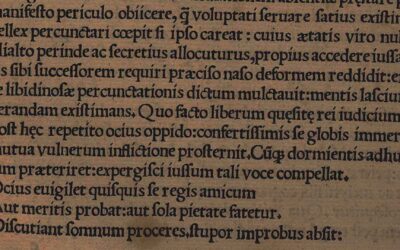Contents
How many times a day do you hit backspace? Or are you perhaps old school and use a real pencil? In that case: how many times a day do you use your rubber (or eraser, if you live across the pond)? Quite a few, right?!
But how many times a day do you erase something Roman style?
Wax And Writing
In ancient Rome, you would use wax tablets to write on. If you needed to make a list, a note, a draft, or just practice your handwriting at school, wasting papyrus or parchment and ink was out of the question. (Bischoff 1990, pp. 7–14) It was too expensive.
Instead, you would use something that could be re-used over and over again. Just like in modern times, the older generations used slate, the ancient Roman generations used wax tablets.
Roman Rubber
In order to write on a wax tablet, the Romans used a special kind of pen called a style or a stilus/stylus. The stilus was sharp and pointy at one end and flat at the other. You wrote with the sharp end in the wax and erased with the flat side, either to make alterations or to write something completely different on the tablet.
Therefore the expression “to turn the pen” or rather Stilum vertere means to erase something or to change or correct something.

Turn Turn Turn
Horace was no stranger to the wax tablet or the stilus and we learn from him, in Satires lib. X.72, that a good writer, a good author, a good poet is never a stranger to turning the pen, or in Horace’s case – the stilus:
“Saepe stilum vertas, iterum quae digna legi sint
scripturus,”
i.e. ”Often must you turn your pencil to erase, if you hope to write something worth a second reading,” (transl. Rushton Fairclough, 1926)
Hieronymus On A Change Of Heart
The expression can also be used in a derived meaning, where the turning of the pen represents a person’s change of opinion. (Boeft & Drijvers, 2013)
The great humanist Erasmus (1466–1536) discusses the expression in his Adagia and mentions Jerome who wrote:
“vertis stilum et omnia laudata prius vituperas”
i.e “you turn your pen and criticize everything you had previously praised”
Simply, you change your mind, your opinion.
This use of the expression seems to be less common, but it is a good metaphor for a change of heart.

Erroneous Erasmus?
In his Adagia, Erasmus goes on to state that Cicero too used the expression stilum vertere in the same sense that Jerome.
This however can be debated as Cicero, in his speech against Verres, wrote:
“Cum haec ad istum afferrentur, pertimuit aliquando et commotus est; vertit stilum in tabulis suis, quo facto causam omnem evertit suam; nihil enim sibi reliqui fecit quod defendi aliqua ratione posset.”
— Cicero, In Verrem, 2.2.101“When this news reached Verres, he was at last thoroughly frightened and upset; and then he applied the blunt end of his style to his records, thereby making an end of all his chances of acquittal, for he has left himself no loop-hole for any sort of defence.” (transl. Greenwood, 1928)
Verres does not seem to have had a change of opinion, but it seems to have been a rather literal erasing of his records. You can read the entire piece from Erasmus down below.
Bonus Latin: Erasmus’ Text
Erasmus of Rotterdam, the trustworthy humanist, never failed to comment on good Latin expressions and wrote a fair amount about stilum vertere in his Adagia.
So, if you are up for some extra reading in Latin, here’s what he has to say about it:
“Stilum vertere est mutare quod scripseris. Horatius in Sermonibus: ‘Saepe stilum vertas.’ Antiquitus in tabellis ceratis scriptitabant stilo graphiario, cuius altera parte nimirum acuta per aequor cereum ducta litteras exarabant, altera latiore rursum oblitterabant, quod exarassent.
Hieronymus Aduersus Rufinum: ‘Quamdiu non renuebam laudationem tuam, sequebaris ut magistrum, fratrem et collegam vocabas et catholicum in omnibus fatebaris. Postquam vero non agnoui laudes tuas et me indignum tanti viri praeconio iudicaui, vertis stilum et omnia laudata prius vituperas de eodem ore et dulce proferens et amarum.’
Hieronymus imitatus est Ciceronem, qui Verrinarum actionum iiii. scribit in hunc modum: ‘Timuit aliquando et commotus est, vertit stilum in tabulis suis, quo facto causam omnem euertit suam.’ Inuenitur et stilum infigere’ et ‘stilo appetere’ pro eo quod est: ‘scriptis insectari atque inuehi’ ”.

References
Bernhard Bischoff, Latin Palaeography: Antiquity & the Middle Ages, transl. Dáibhí Ó Cróinín & David Ganz. Cambridge, 1990.
Horace. Satires. Epistles. The Art of Poetry. Translated by H. Rushton Fairclough. Loeb Classical Library 194. Cambridge, MA: Harvard University Press, 1926.
Jan den Boeft & Jan Willem Drijvers, Philological and Historical Commentary on Ammianus Marcellinus XXIX [Electronic resource], BRILL, 2013, p.118
Cicero. The Verrine Orations, Volume I: Against Caecilius. Against Verres, Part 1; Part 2, Books 1–2. Translated by L. H. G. Greenwood. Loeb Classical Library 221. Cambridge, MA: Harvard University Press, 1928.
















